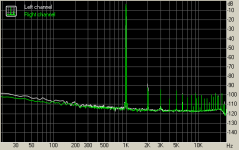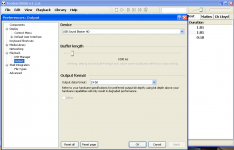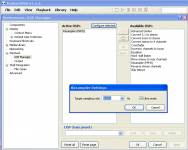This is where we go around the merry-go-round ... foobar ABX only compounds the hardware issue, by reducing the clarity of the playback on my PC, and moving versions closer together in quality - and no alternative to foobar.
However, for the sake of science, , I'll give foobar a go in a moment, between cap1 and cap2, and see what I come up with,
, I'll give foobar a go in a moment, between cap1 and cap2, and see what I come up with,  ...
...
However, for the sake of science,
Hahh! Same old ugly foobar ABX sound, play A, play B - which is worse, hard to say - even when I know which is which, I'm struggling to pick it, there's an unpleasantness to the sound, this is like going to the dentist ...
This is impossible - let's see, it seems that ABX creates temp files, and plays them - let's have a look ... what!! These files are 32 bit format, not 24 bit - look at the original files, yes, they're 24 bit - so, ABX has already screwed up, by changing the format of the files!! Lets try playing one of these twisted files in Nero ... hello, here's that ugly ABX sound again, the PC and DAC doesn't like 32 bit data!
Okay, is there a magic foobar setting for altering this ... noopppe! This software is very special in that it likes to tell you nothing that's going on ... except that, to paraphrase, feeding a higher rate than the hardware likes is not good - duuuhhh!
Stuffed again ... comments ...??
This is impossible - let's see, it seems that ABX creates temp files, and plays them - let's have a look ... what!! These files are 32 bit format, not 24 bit - look at the original files, yes, they're 24 bit - so, ABX has already screwed up, by changing the format of the files!! Lets try playing one of these twisted files in Nero ... hello, here's that ugly ABX sound again, the PC and DAC doesn't like 32 bit data!
Okay, is there a magic foobar setting for altering this ... noopppe! This software is very special in that it likes to tell you nothing that's going on ... except that, to paraphrase, feeding a higher rate than the hardware likes is not good - duuuhhh!
Stuffed again ... comments ...??
Stuffed again ... comments ...??
I feely admit to not knowing much about the ins and outs of what happens when the files gets played on a PC.
I know that if I open media player before opening foobar, then I can set media players graphic etc and that change carries over to foobar even though I close media player and then open foobar.
I know foobar creates temp files and where they live but have never looked at the properties of them. I was more concerned with seeing if they deleted cleanly after use, which they do.
So... are we all stuffed then
It depends whether your playback setup audibly degrades with 32bit files, mine certainly does. The PC came with MediaInfo, a handy downloadable utility that told the story - it's also obvious from the file sizes, temp vs. original. Perhaps foobar ABX can be forced to do otherwise, but the documentation on software like this is always terible ...
Had a bit of a look around - and, definitely stuffed, it appears. foobar ABX turns the file, always, into 32 bit - which means that some on-the-fly translation is likely needed to feed the audio into the hardware, every time a file is played. So much for a transparent ABX process ...  ,
, 
Stuffed again ... comments ...??
Settings.
Unless you start with serious measurements, you will never know what you get. These are great stories, but without any proof.
Had a bit of a look around - and, definitely stuffed, it appears. foobar ABX turns the file, always, into 32 bit - which means that some on-the-fly translation is likely needed to feed the audio into the hardware, every time a file is played. So much for a transparent ABX process ...,

Swelling 16bit data to 24bit or 32bit is no loss data padding when sample rate is kept.
I've measured ABX output with swept sine and MLS. Soundcard I used allows me to route output to any of eight analog outputs and to digital output. Capture of output on external digital recorder, Fostex FR2 digital input returns file to better than 24bit with dither.
As Pavel remarks, this is evasive hand waving unless you perform similar measurements and find errors beyond least significant bit. This is noise well below analog output of 16bit and virtually all commercial 24bit soundcards. Here it becomes weather modulation floor of output op amps is sufficiently deep into 24bit noise floor to be masked by dither, and real noise floor of the analog device.
Clearly, TLE2072 and LM4562 as implemented by Mooly this time are deep in noise floor of his system, and further buried by potential limitations of yours.
That's very helpful, Pavel,Settings.
Unless you start with serious measurements, you will never know what you get. These are great stories, but without any proof.
What I will do is some experiments, get under the hood of foobar so to speak, get my hands greasy and see if I can force a change of behaviour ...
and that some measurements always tell the full story ...
But they do, no way to cheat them, when we speak about correct replay. But you have to do it. Sometimes we say: "JUST DO IT"
The small problem is that the result with Realtek or similar onboard chip will be "not nice", if I stay on polite side
Attachments
Last edited:
Let's see if I can make some facts "stick" in people's memory banks - the DAC is the motherboard unit, unless I pull the machine apart and probe the traces I don't know what it's seeing.As Pavel remarks, this is evasive hand waving unless you perform similar measurements and find errors beyond least significant bit. This is noise well below analog output of 16bit and virtually all commercial 24bit soundcards. Here it becomes weather modulation floor of output op amps is sufficiently deep into 24bit noise floor to be masked by dither, and real noise floor of the analog device.
Clearly, TLE2072 and LM4562 as implemented by Mooly this time are deep in noise floor of his system, and further buried by potential limitations of yours.
There are no errors involved, anywhere ... this is about the SQ changing because of the different nature of the internal processing in the PC affecting the conversion and analogue version of the signal - that's what it's about, like it or not ...
The samples of the opamp sound varied from sample to sample - I used some of the characteristics of the X and Y tracks to set the subjective criteria for sorting the samples, but they obviously weren't the right criteria to use - in medical terms, I was looking at the wrong symptoms.
Comparing messy A with messy B is always difficult - what part of the mess do you focus on? The solution I've found is to lift oneself entirely above the 'mess' level, because that's where the real game is ...
By ear alone I'm happy with the behaviour, apart from loss of resolution at low levels - this is only audible with all the volumes at maximum and my ear pressed against the driver. Meaning, with the tracks so far I would on the road to rapid ear damage if I tried this while they were playing.But they do, no way to cheat them, when we speak about correct replay. But you have to do it. Sometimes we say: "JUST DO IT"
The small problem is that the result with Realtek or similar onboard chip will be "not nice", if I stay on polite side
The Realtek can be 'prodded' into being "nice" - playing of CDs and tracks can be very satisfying, provided all the right things are done - and one of those things is not using foobar ...
Fair enough, Pavel, it is extremely hard to convey sound impressions through words - only Jay, here, seems to 'get it', he's learnt to tune into the aspects that matter ...
I'll leave this with a last rejoinder: with the Steely Dan track, and orig, on Nero I was getting a remarkable good rendition of what real cymbals sound like. In foobar ABX, with every version of the track, it was someone in the kitchen banging away on a saucepan with a soupspoon ...
I'll leave this with a last rejoinder: with the Steely Dan track, and orig, on Nero I was getting a remarkable good rendition of what real cymbals sound like. In foobar ABX, with every version of the track, it was someone in the kitchen banging away on a saucepan with a soupspoon ...
I was wondering if any good would come of using a piece of software called foobar.So... are we all stuffed then
As always, Wiktionary gives a nice, concise explanation.
Attachments
Fair enough, Pavel, it is extremely hard to convey sound impressions through words - only Jay, here, seems to 'get it', he's learnt to tune into the aspects that matter ...
Frank, in fact I do not mean anyone in personal, my point is that subjective sound description, experienced with very different hardware and in different parts of the world, does not provide much helpful information/feedback, unless there is a direct meeting and 2 people can make a listening test together, on same equipment, or to compare different components.
With my D/A system, only the attached setting gives spectrally pure results and also best sounding. Everything else adds unwanted digital artifacts.
Attachments
Last edited:
- Status
- This old topic is closed. If you want to reopen this topic, contact a moderator using the "Report Post" button.
- Home
- General Interest
- Everything Else
- Listening Test Part 2. Active Circuitry.



